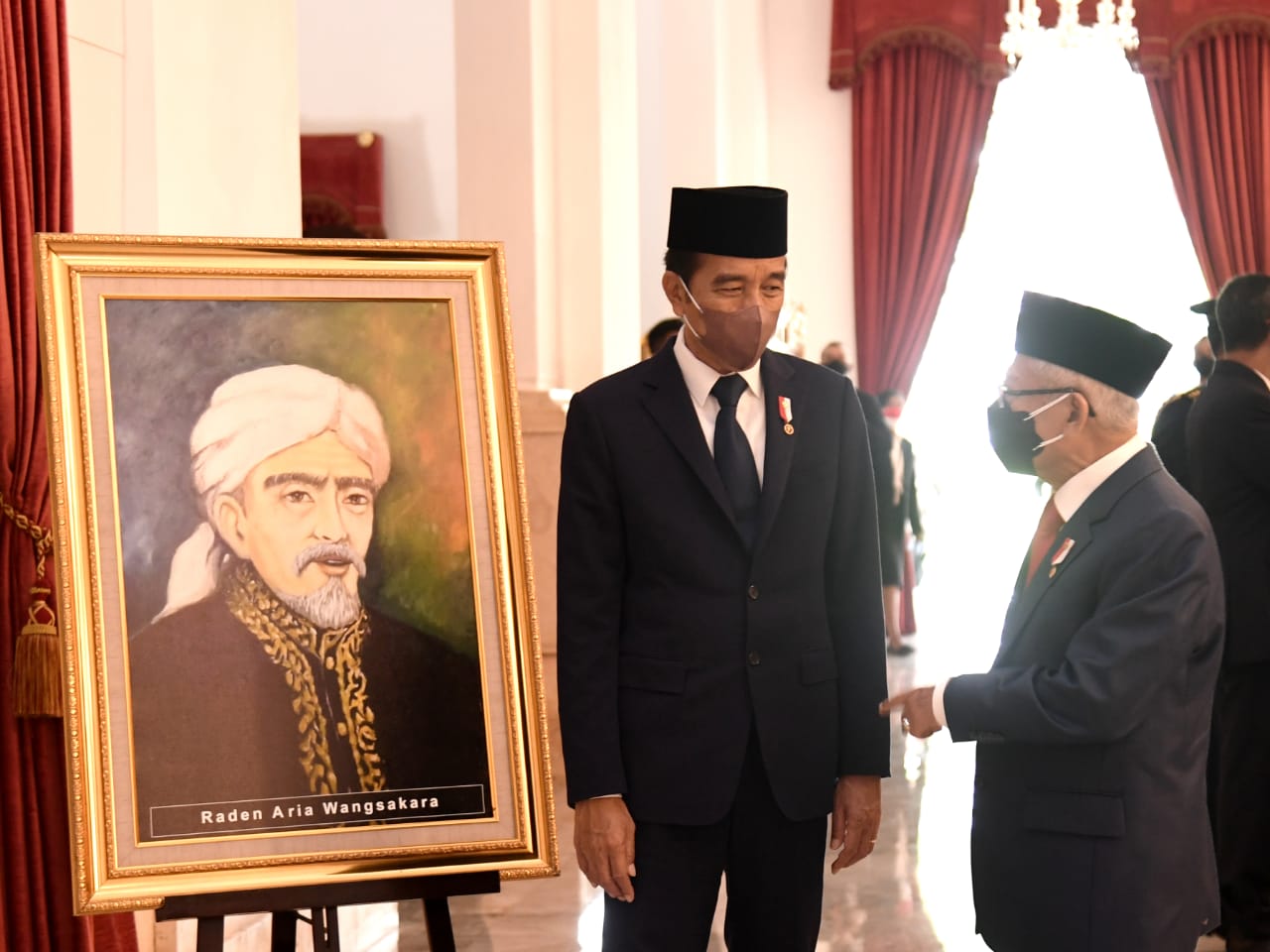President Jokowi Appoints Four Historical Figures as National Heroes

President Jokowi talks with Vice President Ma’ruf Amin in front of the painting of Raden Aria Wangsakara, a figure from Banten who was just awarded the title of National Hero on Wednesday (10/11). (Photo: BPMI/Rusman)
President Joko “Jokowi” Widodo Wednesday (11/10) named four historical figures as national heroes during the commemoration of the 2021 Heroes Day at the State Palace in Jakarta.
The four figures are Usmar Ismail, from capital Jakarta; Raden Aria Wangsakara from Banten province; Tombolotutu from Central Sulawesi province; and Sultan Aji Muhammad Idris from East Kalimantan province.
Here are the profiles of the four figures:
- Usmar Ismail from capital region of Jakarta
Usmar Ismail was born in Bukittinggi on 20 March 1921. He is one of the pioneers in the national and international film industry. His greatest contribution is in advancing and building the national film industry that is internationally recognized. It is a noteworthy achievement in the journey of the Indonesian nation.
In 1944, Usmar founded the Maya theater group which also helped disseminate news of the proclamation of Indonesia independence. Then in 1950, he established a national film company called N.V. Perfini (Indonesian National Film Company) who later made the film Darah dan Doa (the long march of Siliwangi). This film is considered to be the first Indonesian film and then the first day of the film shooting is designated as Indonesian Film Day.
In 1962, Usmar established the Indonesian Muslim Cultural Arts Institute (Lesbumi) under the biggest Islamic organization Nahdlatul Ulama (NU) as a forum for cultural activities, education, and disseminating the values of nationalism in society.
Umar Ismail’s films contain nationalist values such as Darah dan Doa (1950), Enam Jam di Jogja (1961), Kafedo (1953), Lewat Djam Malam (1954), Pedjuang (1960), and many others.
In addition, the film Tamu Agung (1956) was awarded the best comedy film at the Asia Pacific Film Festival in Hong Kong in 1956.
Usmar died on 2 January 1971 and was buried in Karet Cemetery, Jakarta.
- Raden Aria Wangsakara from Banten province
Raden Aria Wangsakara was born in Sumedang in 1615. Wangsakara was not only a religious figure in the Banten Sultanate of that time, but also a political figure and military leader who continued to fight the invaders. His struggle during the reigns of Sultan Abul Mufakhir and Sultan Ageng Tirtayasa emphasized his role as a figure who also played an important role in fighting against the invaders (VOC).
In 1636, the Sultan sent Wangsakara on a pilgrimage. In Mecca city, Wangsakara obtained a letter of recognition for Banten by Syarif Mecca as an extension of the political authority of the Ottoman Turks. Upon his return to Banten, Wangsakara was given the title Kiai Mas Haji Wasangraja.
In 1654, during a war in Batavia between the Sultanate of Banten and the VOC, Raden Aria Wangsakara represented the Sultanate of Banten as a negotiator which resulted in an agreement to end the war. The respective areas controlled by each party will be maintained.
In 1658-1659 when the war occurred, Raden Aria Wangsakara received a mandate from Sultan Ageng Tirtayasa to lead the war against the VOC which led to a peace treaty on July 5, 1659.
After the war, Wangsakara changed its defense strategy by making settlements and canals reached the inner area of Tangerang.
Wangsakara died on 15 August 1681 and was buried in the Tangerang Regency Heroes Cemetery.
- Tombolotutu from Central Sulawesi province
Tombolotutu was born in Moutong, Central Sulawesi province in 1857. He was a figure who consistently opposed the Dutch colonialism in Moutong. Tombolotutu led and fought for the the Moutong people’s rights that were taken away, resulting in a battle that not only claimed many lives but also caused material losses.
He also refused to sign the “Lang Contract”, an agreement proposed by the Dutch because it was considered detrimental to the community.
Tombolotutu died on 17 February 1901 and was buried in Padang village, Toribulu district, Moutong, Central Sulawesi province.
- Sultan Aji Muhammad Idris from East Kalimantan province.
Sultan Aji Muhammad Idris was born in Jembayan, Kutai Kartanegara, East Kalimantan province in 1667. Sultan Aji is a unifying figure who can be a source of inspiration for the Indonesian people. He tried to establish relations and unite forces with various sultanates in the country to oppose colonialism.
When the VOC began to control the kingdom of Kutai Kartanegara and the Kingdom of Pasir, Sultan Aji as the Prince of Kutai continued to fight. Sultan Aji Muhammad Idris consistently expelled the VOC forces from East Kalimantan province, South Sulawesi province, and Indonesia as a whole.
Sultan Aji succeeded in uniting the kingdoms in the South Sulawesi region, especially the Bugis kingdoms such as Wajo, Bone, and Soppeng.
Sultan Aji died in 1739 and was buried in the family cemetery of King Wajo, South Sulawesi province. (PR Ministry of Social Affairs/UN) (EST/LW)








